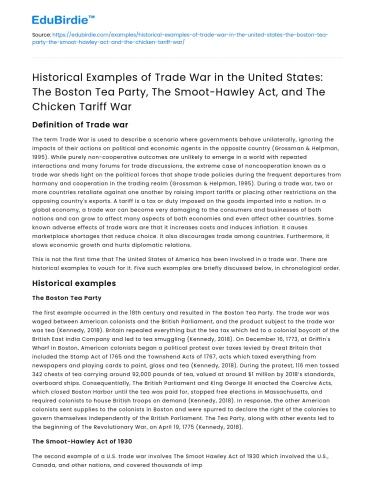Definition of Trade war
The term Trade War is used to describe a scenario where governments behave unilaterally, ignoring the impacts of their actions on political and economic agents in the opposite country (Grossman & Helpman, 1995). While purely non-cooperative outcomes are unlikely to emerge in a world with repeated interactions and many forums for trade discussions, the extreme case of noncooperation known as a trade war sheds light on the political forces that shape trade policies during the frequent departures from harmony and cooperation in the trading realm (Grossman & Helpman, 1995). During a trade war, two or more countries retaliate against one another by raising import tariffs or placing other restrictions on the opposing country's exports. A tariff is a tax or duty imposed on the goods imported into a nation. In a global economy, a trade war can become very damaging to the consumers and businesses of both nations and can grow to affect many aspects of both economies and even affect other countries. Some known adverse effects of trade wars are that it increases costs and induces inflation. It causes marketplace shortages that reduce choice. It also discourages trade among countries. Furthermore, it slows economic growth and hurts diplomatic relations.
This is not the first time that The United States of America has been involved in a trade war. There are historical examples to vouch for it. Five such examples are briefly discussed below, in chronological order.
Save your time!
We can take care of your essay
- Proper editing and formatting
- Free revision, title page, and bibliography
- Flexible prices and money-back guarantee
Historical examples
The Boston Tea Party
The first example occurred in the 18th century and resulted in The Boston Tea Party. The trade war was waged between American colonists and the British Parliament, and the product subject to the trade war was tea (Kennedy, 2018). Britain repealed everything but the tea tax which led to a colonial boycott of the British East India Company and led to tea smuggling (Kennedy, 2018). On December 16, 1773, at Griffin's Wharf in Boston, American colonists began a political protest over taxes levied by Great Britain that included the Stamp Act of 1765 and the Townshend Acts of 1767, acts which taxed everything from newspapers and playing cards to paint, glass and tea (Kennedy, 2018). During the protest, 116 men tossed 342 chests of tea carrying around 92,000 pounds of tea, valued at around $1 million by 2018’s standards, overboard ships. Consequentially, The British Parliament and King George III enacted the Coercive Acts, which closed Boston Harbor until the tea was paid for, stopped free elections in Massachusetts, and required colonists to house British troops on demand (Kennedy, 2018). In response, the other American colonists sent supplies to the colonists in Boston and were spurred to declare the right of the colonies to govern themselves independently of the British Parliament. The Tea Party, along with other events led to the beginning of The Revolutionary War, on April 19, 1775 (Kennedy, 2018).
The Smoot-Hawley Act of 1930
The second example of a U.S. trade war involves The Smoot Hawley Act of 1930 which involved the U.S., Canada, and other nations, and covered thousands of imported goods. President Herbert Hoover proposed tariffs on agricultural imports as he set out to deal with a farm crisis during the early years of the Great Depression. Senators Reed Smoot and Willis C. Hawley offered their own legislation and added many industrial tariffs (Kennedy, 2018). These tariffs were added despite a petition signed by 1,000 U.S. economists calling for President Hoover to veto the plan. Canada, along with other nations responded with tariffs on U.S. exports, adding more strain to the already-devastated U.S. economy. The result was a disaster because the retaliation from other countries contributed to U.S. exports falling by 61 percent in 1933 and stalling economic recovery during the Depression. Specifically, in 1929, the U.S. exported $5.24 billion worth of goods but in 1933, exports were a mere $1.68 billion. Factored in inflation, which was less than exports in 1896 (Gordon, 2017). World trade declined by 65% between 1929 and 1934, as country after country increased tariffs. The stock market, which had recovered about a third of what it had lost in the crash of 1929, began to sink again as soon as it became clear that Smoot-Hawley would pass and bank failures began to multiply (Gordon, 2017). Thanks largely to the negative economic effects of Smoot-Hawley, President Hoover lost the next election to Franklin D. Roosevelt. The Trade Agreements Act of 1934 replaced Smoot-Hawley, and the new law allowed the president to negotiate tariff reductions (Kennedy, 2018).
The Chicken Tariff War of the 1960s
The third example is The Chicken Tariff War of the 1960s which involved the United States, France, and West Germany and covered chicken, brandy, trucks, and other items. The increase in mass-produced, factory-farmed chicken in America led to decreased prices and vastly increased chicken exports to Europe, particularly France and West Germany (Kennedy, 2018). European countries like France and West Germany responded by imposing tariffs on chicken, leading to significant losses in the U.S. poultry industry. The United States, led by President Lyndon Johnson, fought back with a 25 percent tax on light trucks, (including Volkswagen buses), French brandy, potato starch, and dextrin (Kennedy, 2018).






 Stuck on your essay?
Stuck on your essay?

